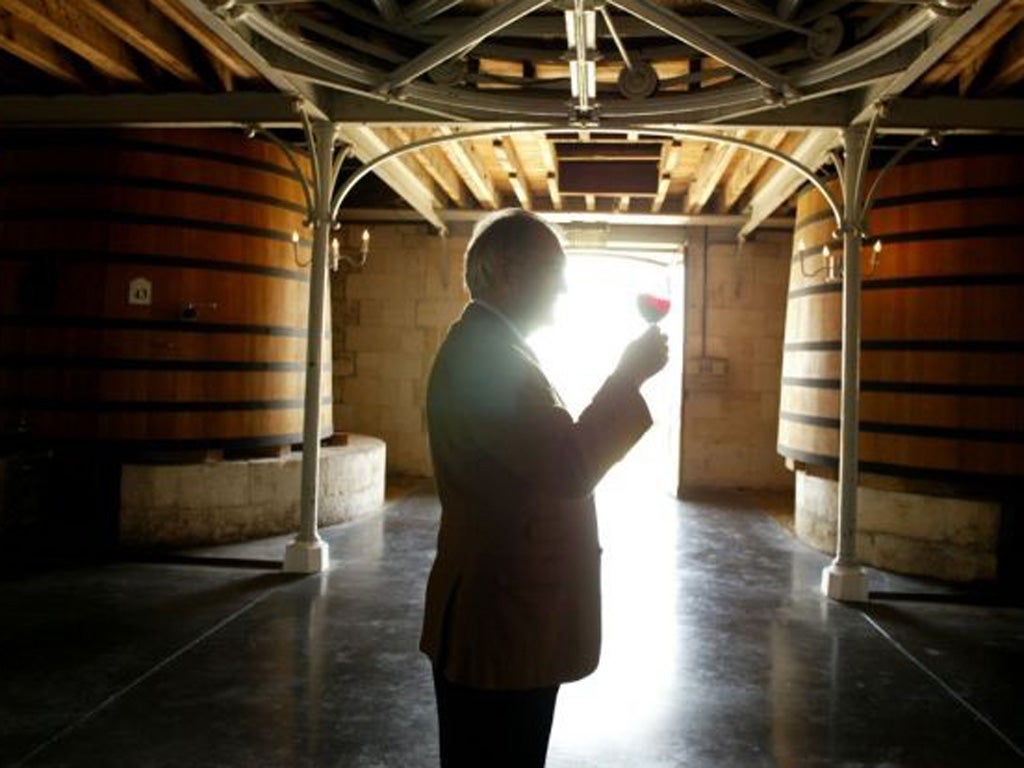The Bordeaux bubble bursts – so will dealers go into the red?
Prices plummet by 30 per cent as industry pins hopes for revival on China's new rich

Bargains! Bargains! Some of the most prized red wines in the world are available from Bordeaux this year at a discount of around 30 per cent.
There are some catches, however. Your wine will not be bottled for another couple of years. You should not consider drinking it until at least 2022. And the word "bargain" is relative.
You can buy, for instance, the Château Lafite-Rothschild 2011 for as little as €600 (£480) a bottle. This time last year the 2010 vintage of the same wine was selling at €900 a bottle. Similar "discounts" are available on wine from most – not all – of the top Bordeaux châteaux as the "primeur" season for advance sales of last September's harvest comes to an end. After a stupendous increase of 2,000 per cent in the most prized labels since 1982, the bubble in posh Bordeaux wines appears to have popped this year. Or at least to have deflated.
This is not the first time that the prices for "primeurs", or wine futures, have fallen, but it is the first time they have fallen so far and so widely. Some wine traders, especially from America and Britain, say that the surprise – and the pity – is that they have not fallen further.
Huge sales to China, and to a lesser extent Russia and other "nouveaux riches" countries, have kept prices for the top 20 to 30 châteaux relatively high. Prices for some of the magical names – Château Pétrus or Château Le Pin – have scarcely fallen at all (€1,300 for a still-unbottled bottle).
The 2011 red Bordeaux or "claret" vintage is said to be reasonable but "variable" – code for "poor" in some cases. After superlative vintages in 2005, 2009 and 2010, it was predictable that primeur sale prices would fall somewhat this spring.
Some wine traders were hoping that the "variable" quality of the 2011 claret would lead to a permanent "correction" in a market which they say has lost touch with economic – and oenological – reality.
One British trader told The Independent: "Without the Chinese and others the price for many châteaux would have been much, much lower. Some traders are still trying to re-sell their 2010 Bordeaux and that was, for the most part, a much better wine. By comparison, 2011 is on the dull side."
The primeur market is unique to Bordeaux. It does not involve the hundreds of low-priced châteaux which produce wines at €5 to €10 bottle (which have gained no benefit from the craze for high-priced Bordeaux). It involves the haute-bourgeoisie and aristocracy of the Bordeaux châteaux, but especially the 250 most sought after producers of red Bordeaux.
The original intention of the primeur sales was to guarantee cash flow to the vineyards, but the resulting speculation has led, for example, to a bottle of Château Latour rising from the equivalent of €39 in 1982 to €1,200 this year.
Since the 1980s, there has been speculation in wine futures, especially in the United States. Seeing five-year-old bottles of their wine selling for astronomic amounts, top châteaux were tempted to ramp up their original asking price. And so the bubble grew.
Just as the economic crisis appeared ready to end the speculation in 2008, two factors pumped it up again. The vintages in 2009 and 2010 were among the finest ever. At the same time, a new market emerged for high-priced Bordeaux in China. In volume terms, China is now the largest export market, buying 58 million bottles in 2011. Chinese investors have bough 16 vineyards in Bordeaux in the past two years.
There also seems to be a willingness – even a sense of pride – on the part of the new super-rich in China to pay absurdly high prices for bottles carrying the top Bordeaux labels. "In the case of the US or Europe, it is difficult to imagine that there are many people willing to consume a €3,000 bottle of wine," a Bordeaux trader told The Independent. "Many of those bottles seem to be fated to be stored and traded indefinitely. In China, when the wine is ready, it is drunk, whatever the price."
Vin extraordinaire: The 2011 top four
Despite the declines, at least four châteaux commanded four-figure sums for bottles of their 2011 vintage.
Château Cheval Blanc
Up to €1,100 a bottle. The Cheval Blanc is one of the most prized of the Saint-Emilion wines.
Château Latour
Up to €1,200. Latour is seen as one of the aristocrats of the Medoc, west of the Gironde.
Château Pétrus
Up to €1,300 a bottle. Petrus is the greatest of the Pomerol wines from east of the river.
Château Le Pin
Up to €1,300 a bottle. A cult, tiny vineyard within the Pomerol area.
Subscribe to Independent Premium to bookmark this article
Want to bookmark your favourite articles and stories to read or reference later? Start your Independent Premium subscription today.

Join our commenting forum
Join thought-provoking conversations, follow other Independent readers and see their replies